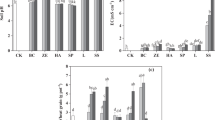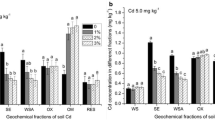Abstract
The purpose of this study is to evaluate the phytoextraction of cadmium (Cd) from contaminated soils by switchgrass (Panicum virgatum L.), which is a promising energy crop with high biomass. Two ecotypes of switchgrass cultivars, Alamo and Blackwell, were investigated in a pot experiment. Dry weight and plant Cd concentration of the switchgrass plants growing on Cd-spiked soils (0, 20, and 60 mg Cd kg−1 soil) with chelating agent amendments (1 g kg−1 citric acid [CA] and 0.1 g kg−1 ethylene diaminetetraacetic acid [EDTA]) were measured to examine the phytotoxicity and accumulation of Cd in the switchgrass. Fractions of Cd (F1, exchangeable; F2, carbonate; F3, Fe–Mn oxide; F4, organic matter; F5, residual) for the soils sampled at the time of harvesting were also determined using chemically sequential extractions. In the results, the dry weight of the switchgrass decreased with increasing Cd, with a significant dry weight reduction when Cd exceeded 20 mg kg−1. However, the high Cd spike of 60 mg kg−1 was not lethal to Alamo and Blackwell, which suggests that switchgrass plants can tolerate Cd and grow in contaminated soils. Compared with the control, the CA and EDTA amendments had no adverse effect on the growth of switchgrass plants. With regard to Cd accumulation, higher plant Cd concentrations were frequently found after CA amendment in Alamo; however, the Cd concentrations of Blackwell plants may increase when amended with EDTA. On the basis of the fractionation of soil Cd, dry weight and plant Cd concentration could be expressed as a function of Cd fractionation to predict the phytoextraction of Cd. Thus, the fractionation of Cd is a useful approach for evaluating the phytoextraction of Cd by switchgrass in contaminated soils. According to the comparison of phytoextractions of Cd between Alamo and Blackwell, Alamo plants removed substantially more Cd from Cd-spiked soils than Blackwell. Therefore, Alamo is better suited for the phytoextraction of Cd from contaminated soils.

Similar content being viewed by others
References
Adler PR, Sanderson MA, Boateng AA, Weimer PJ, Jung HG (2006) Biomass yield and biofuel quality of switchgrass harvested in fall or spring. Agron J 98:1518–1525
Alkorta I, Hernández-Allica J, Becerril JM, Amezaga I, Albizu I, Garbisu C (2004) Recent findings on the phytoremediation of soils contaminated with environmentally toxic heavy metals and metalloids such as zinc, cadmium, lead, and arsenic. Rev Environ Sci Biotechnol 3:71–90
Arduini I, Masoni A, Ercoli L (2006) Effects of high chromium applications on miscanthus during the period of maximum growth. Environ Exp Bot 58:234–243
Brown SL, Chaney RL, Angle JS, Baker AJM (1994) Phytoremediation potential of Thlaspi caerulescens and bladder campion for zinc- and cadmium-contaminated soil. J Environ Qual 23:1151–1157
Byrd GT, May PA 2 (2000) Physiological comparisons of switchgrass cultivars differing in transpiration efficiency. Crop Sci 40:1271–1277
Carapeto C, Purchase D (2000) Use of sequential extraction procedures for the analysis of cadmium and lead in sediment samples from a constructed wetland. Bull Environ Contam Toxicol 64:51–58
Casler MD, Boe AR (2003) Cultivar × environment interactions in switchgrass. Crop Sci 43:2226–2233
Cassida KA, Muir JP, Hussey MA, Reed JC, Venuto BC, Ocumpaugh WR (2005) Biomass yield and stand characteristics of switchgrass in south central U.S. environments. Crop Sci 45:673–681
Chen M, Ma LQ (2001) Comparison of three aqua regia digestion for twenty Florida soils. Soil Sci Soc Am J 65:491–499
Chen YX, Lin Q, Luo YM, He YF, Zhen SJ, Yu YL, Tian GM, Wong MH (2003) The role of citric acid on the phytoremediation of heavy metal contaminated soil. Chemosphere 50:807–811
Deram A, Denayer FO, Petit D, Haluwyn CV (2006) Seasonal variations of cadmium and zinc in Arrhenatherum elatius, a perennial grass species from highly contaminated soils. Environ Pollut 140:62–70
Elkhatib EA, Thabet AG, Mahdy AM (2001) Phytoremediation of cadmium contaminated soils: role of organic complexing agents in cadmium extraction. Land Contam Reclam 9:359–366
Entry JA, Watrud LS (1998) Potential remediation of 137Cs and 90Sr contaminated soil by accumulation in Alamo switchgrass. Water Air Soil Pollut 104:339–352
Evers GW, Parsons MJ (2003) Soil type and moisture level influence on Alamo switchgrass emergence and seedling growth. Crop Sci 43:288–294
Gee GW, Bauder JW (1986) Particle-size analysis. In: Klute A (ed) Methods of soil analysis, part 1, physical and mineralogical methods. ASA and SSSA, Madison, pp 383–411
Hammer D, Keller C (2002) Changes in the rhizosphere of metal-accumulating plants evidenced by chemical extractants. J Environ Qual 31:1561–1569
Jalali M, Ranjbar F (2010) Aging effects on phosphorous transformation rate and fractionation in some calcareous soils. Geoderma 155:101–106
Juang KW, Liao WJ, Liu TL, Tsui L, Lee DY (2008) Additional sampling based on regulation threshold and kriging variance to reduce the probability of false delineation in a contaminated site. Sci Total Environ 389:20–28
Krishnamurti GSR, Naidu R (2002) Solid-phase speciation and phytoavailability of copper and zinc in soils. Environ Sci Technol 36:2645–2651
Li Z, Shuman LM (1996) Heavy metal movement in metal-contaminated soil profiles. Soil Sci 161:656–666
Li YM, Chaney RI, Brewer E, Roseberg RJ, Angle JS, Baker AJM, Reeves RD, Nelkin J (2003) Development of a technology for commercial phytoextraction of nickel: economic and technical considerations. Plant Soil 249:107–115
Liphadzi MS, Kirkham MB (2006) Availability and plant uptake of heavy metals in EDTA-assisted phytoremediation of soil and composted biosolids. S Afr J Bot 72:391–397
Luo YM, Christie P (1998) Bioavailability of copper and zinc in soils treated with alkaline stabilized sewage sludges. J Environ Qual 27:335–342
Ma Z, Wood CW, Bransby DI (2000) Impacts of soil management on root characteristics of switchgrass. Biomass Bioenergy 18:105–112
Madakadze IC, Coulman BE, Peterson PR, Stewart KA, Samson R, Smith DL (1998) Leaf area development, light interception, and yield among switchgrass populations in a short-season area. Crop Sci 38:827–834
Madakadze IC, Stewart KA, Peterson PR, Coulman BE, Smith DL (1999) Cutting frequency and nitrogen fertilization effects on yield and nitrogen concentration of switchgrass in a short season area. Crop Sci 39:552–557
McGrath SP, Zhao FJ (2003) Phytoextraction of metals and metalloids from contaminated soils. Curr Opin Biotechnol 14:277–282
McLean EO (1982) Soil pH and lime requirement. In: Page AL, Miller RH, Keeney DR (eds) Methods of soil analysis, part 2, chemical and microbiological properties. ASA and SSSA, Madison, pp 199–223
Muir JP, Sanderson MA, Ocumpaugh WR, Jones RM, Reed RL (2001) Biomass production of ‘Alamo’ switchgrass in response to nitrogen, phosphorus, and row spacing. Agron J 93:896–901
Munn J, January M, Cutright TJ (2008) Greenhouse evaluation of EDTA effectiveness at enhancing Cd, Cr, and Ni uptake in Helianthus annuus and Thlaspi caerulescens. J Soils Sediments 8:116–122
Nelson DW, Sommers LE (1996) Total carbon, organic carbon, and organic matter. In: Sparks DL (ed) Methods of soil analysis, part 3, chemical methods. ASA and SSSA, Madison, pp 961–1010
Padmavathiamma PK, Li LY (2010) Phytoavailability and fractionation of lead and manganese in a contaminated soil after application of three amendments. Bioresour Technol 101:5667–5676
Pulford ID, Watson C (2003) Phytoremediation of heavy metal-contaminated land by trees—a review. Environ Int 29:529–540
Quartacci MF, Argilla A, Baker AJM, Navari-Izzo F (2006) Phytoextraction of metals from a multiple contaminated soil by Indian mustard. Chemosphere 63:918–925
Reed RL, Sanderson MA, Allen VG, Matches AG (1999) Growth and cadmium accumulation in selected switchgrass cultivars. Commun Soil Sci Plant Anal 30:2655–2667
Reed RL, Sanderson MA, Allen VG, Zartman RE (2002) Cadmium application and pH effects on growth and cadmium accumulation in switchgrass. Commun Soil Sci Plant Anal 33:1187–1203
Reeves RD, Schwartz C, Morel JL, Edmondson J (2001) Distribution and metal-accumulating behavior of Thlaspi caerulescens and associated metallophytes in France. Int J Phytoremediat 3:145–172
Römkens P, Bouwman L, Japenga J, Draaisma C (2002) Potentials and drawbacks of chelate-enhanced phytoremediation of soils. Environ Pollut 116:109–121
Salt DE, Prince RC, Pickering IJ, Raskin I (1995) Mechanisms of cadmium mobility and accumulation in Indian mustard. Plant Physiol 109:1427–1433
Salt DE, Smith RD, Raskin I (1998) Phytoremediation. Annu Rev Plant Physiol Plant Mol Biol 49:643–648
SAS Institute Inc (1985) SAS/STAT User’s guide, version 5. SAS Institute, Cary
Shahandeh H, Hossner LR (2000) Plant screening for chromium phytoremediation. Int J Phytoremediat 2:31–51
Sladden SE, Bransby DI, Aiken GE (1991) Biomass yield, composition and production costs for eight switchgrass varieties in Alabama. Biomass Bioenergy 1:119–122
Stroup AJ, Sanderson MA, Muir JP, McFarland MJ, Reed RL (2003) Comparison of growth and performance in upland and lowland switchgrass types to water and nitrogen stress. Bioresour Technol 86:65–72
Tessier A, Campbell PGC, Bisson M (1979) Sequential extraction procedure for the speciation of particulate trace metals. Anal Chem 51:844–851
Thomas GW (1982) Exchangeable cations. In: Page AL, Miller RH, Keeney DR (eds) Methods of soil analysis, part 2, chemical and microbiological properties. ASA and SSSA, Madison, pp 159–165
Zhang X, Xia H, Li Z, Zhuang P, Gao B (2010) Potential of four grasses in remediation of Cd and Zn contaminated soils. Bioresour Technol 101:2063–2066
Zhao FJ, Lombi E, McGrath SP (2003) Assessing the potential for zinc and cadmium phytoremediation with the hyperaccumulator Thlaspi caerulescens. Plant Soil 249:37–43
Zhuang P, Ye ZH, Lan CY, Xie ZW, Shu WS (2005) Chemically assisted phytoextraction of heavy metal contaminated soils using three plant species. Plant Soil 276:153–162
Acknowledgments
This research was sponsored by the National Science Council, Taiwan under grant nos. NSC 96-2313-B-451-003 and NSC 97-2313-B-451-009-MY3.
Author information
Authors and Affiliations
Corresponding author
Rights and permissions
About this article
Cite this article
Chen, BC., Lai, HY., Lee, DY. et al. Using chemical fractionation to evaluate the phytoextraction of cadmium by switchgrass from Cd-contaminated soils. Ecotoxicology 20, 409–418 (2011). https://doi.org/10.1007/s10646-010-0592-y
Accepted:
Published:
Issue Date:
DOI: https://doi.org/10.1007/s10646-010-0592-y




